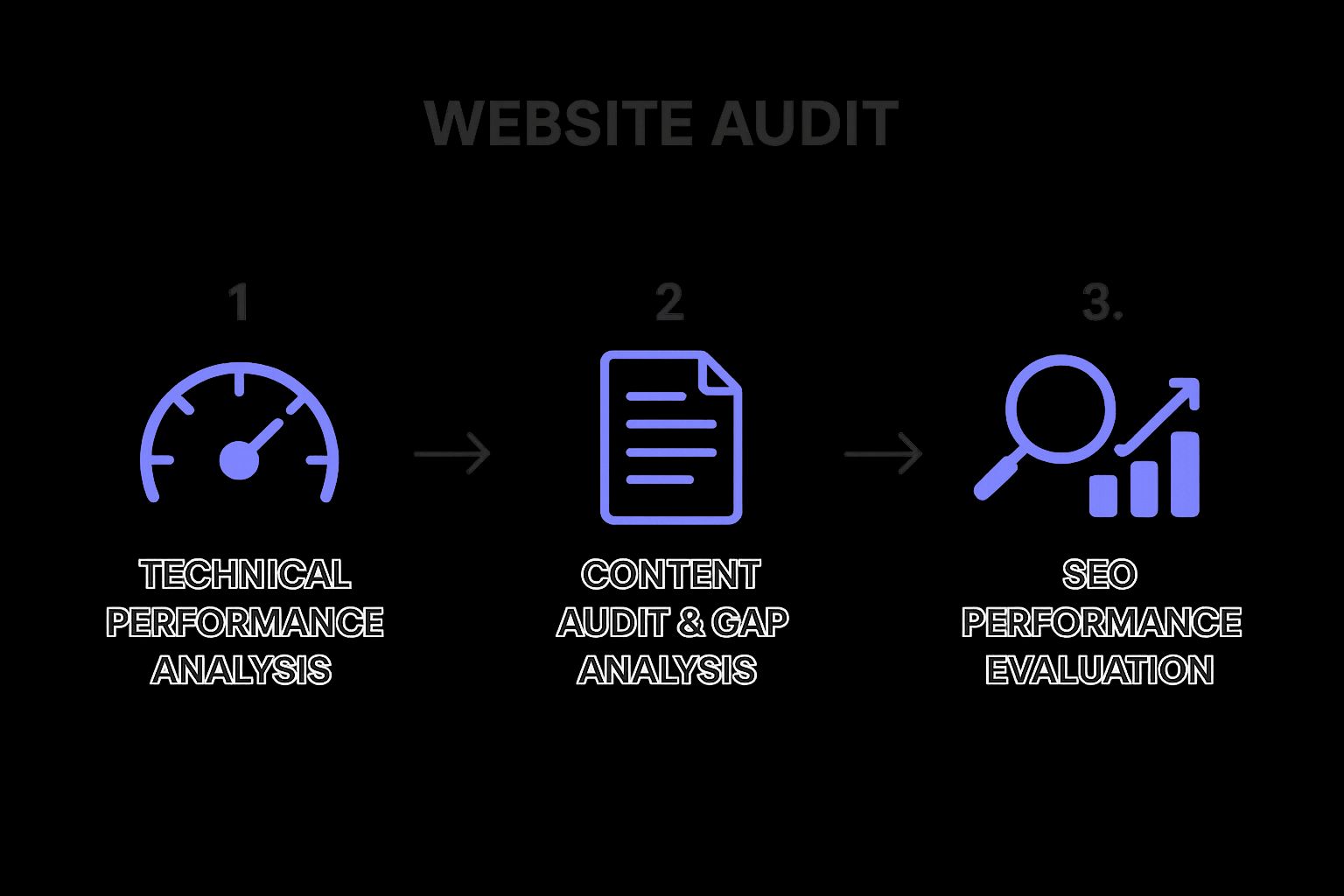Embarking on a website redesign can feel like navigating a maze without a map. It's a significant investment of time and resources, and the stakes are high. A successful redesign can skyrocket conversions and user engagement, while a poorly planned one can tank your SEO and alienate your audience. That's why having a structured plan is not just helpful; it's essential for achieving your desired outcomes. This comprehensive website redesign checklist is your step-by-step guide, transforming a daunting task into a manageable, strategic process from start to finish.
We will break down the entire project into eight critical phases, ensuring no stone is left unturned. You will learn how to:
- Audit your existing site to identify what works and what doesn't.
- Define clear, measurable goals and success metrics.
- Plan your site structure and content strategy for maximum impact.
- Execute the design, development, and launch with precision.
Whether you're a seasoned developer, a business owner, or a marketing expert using powerful tools like Elementor and Exclusive Addons, this checklist provides the actionable blueprint you need. Following these steps will empower you to build a website that not only looks stunning but also performs exceptionally well, driving growth for your business.
1. Comprehensive Website Audit & Analysis: Setting Your Baseline
Embarking on a website redesign without a preliminary audit is like setting sail without a map. Before you alter a single element, you must deeply understand your current site's performance. This foundational step in any successful website redesign checklist provides a data-driven snapshot of what works, what doesn’t, and where hidden opportunities lie.
A comprehensive audit goes beyond a simple glance at aesthetics. It involves a meticulous analysis of technical health, content effectiveness, SEO rankings, and user experience. By gathering this baseline data, you ensure your redesign decisions are rooted in evidence, not assumptions. This prevents repeating past mistakes and sets the stage for measurable improvements. For instance, Airbnb's major 2014 redesign was famously driven by extensive user behavior analysis that uncovered critical navigation and booking friction points, leading to a more intuitive and profitable platform.
Key Audit Areas
To execute a thorough audit, concentrate on these three core pillars:
- Technical Performance: Use tools like Google PageSpeed Insights to measure load times, mobile-friendliness, and core web vitals. Slow speeds and poor mobile rendering are common reasons users abandon a site.
- Content & UX Analysis: Employ heat mapping tools like Hotjar to see where users click, scroll, and drop off. Combine this with a content inventory to identify underperforming pages, outdated information, and gaps in your marketing funnels.
- SEO & Traffic Analysis: Dive into Google Analytics and SEMrush. Document your top-performing keywords, highest traffic pages, and backlink profile. You need to protect these assets during the migration to avoid a catastrophic drop in organic traffic post-launch.
The following infographic illustrates the initial sequence of a comprehensive website audit, highlighting the first three critical analysis stages.

This process flow visualizes how a structured audit moves from technical foundations to content strategy and finally to search visibility, ensuring no critical area is overlooked.
2. Define Clear Goals & Success Metrics: Charting Your Course for Success
Initiating a redesign without clear objectives is like building a house without a blueprint. Before drafting a wireframe or writing a line of code, you must define what success looks like. This crucial step in any effective website redesign checklist transforms the project from a purely aesthetic exercise into a strategic business initiative, ensuring every decision serves a specific, measurable purpose.
Defining goals and their corresponding Key Performance Indicators (KPIs) aligns all stakeholders, from designers to executives, on a unified vision. It provides a framework for prioritizing features and a benchmark against which you can measure the new site's ROI. For example, Dropbox's significant 2017 redesign wasn't just about a new look; it was driven by the clear business goal of repositioning itself as a creative collaboration hub, which guided every design choice to attract a new target audience.
Key Goal-Setting Areas
To establish a robust framework for your redesign, focus on these three critical components:
- Business Objectives: Align website goals directly with broader company objectives. Do you want to increase qualified leads by 30%, reduce customer support tickets by 15%, or boost direct online sales by 20%? These high-level targets will dictate the site's primary function.
- User-Centric Goals: Think about what you want your users to achieve. This could be reducing the time it takes for a new user to sign up, increasing the number of downloads for a whitepaper, or improving the findability of key information. A better user experience directly supports business goals.
- SMART Criteria: Apply the SMART framework to every objective. Goals must be Specific (e.g., "increase newsletter sign-ups"), Measurable (by 25%), Achievable (based on current traffic), Relevant (to our Q3 marketing push), and Time-bound (within six months post-launch). This rigor removes ambiguity and creates accountability.
3. User Research & Persona Development: Designing for Real People
Redesigning a website without deeply understanding its users is like designing a product for an imaginary customer. User research is a non-negotiable step in any professional website redesign checklist, shifting the focus from internal assumptions to the actual needs, behaviors, and pain points of your target audience. It is the process that ensures your new design resonates with, serves, and converts the people who matter most.
This critical phase involves gathering both qualitative and quantitative data to build detailed user personas: semi-fictional representations of your ideal customers. These data-backed profiles guide every subsequent design and content decision, from navigation structure to button copy. For example, Uber’s app redesign was driven by distinct persona insights for both riders and drivers, resulting in a more streamlined and intuitive experience for each user group and addressing their unique challenges.

Key Research Areas
To develop effective, actionable personas, focus your research on these three essential components:
- Qualitative Data Collection: Conduct one-on-one interviews, focus groups, and usability tests with current and potential customers. Ask open-ended questions to uncover their motivations, frustrations, and goals related to your product or industry. This gives you the "why" behind user actions.
- Quantitative Data Analysis: Use surveys and website analytics (like Google Analytics) to gather statistical data on user demographics, behavior flows, and conversion paths. This provides the "what" and "how many," validating your qualitative findings at scale.
- Persona & Journey Map Creation: Synthesize all your research into 2-4 detailed user personas. Each persona should have a name, photo, goals, and key pain points. Then, create user journey maps that visualize the steps each persona takes to achieve a goal on your site, identifying opportunities for improvement.
This research-first approach, popularized by pioneers like Alan Cooper, guarantees that your redesign is not just aesthetically pleasing but fundamentally user-centric, leading to higher engagement and conversion rates.
4. Information Architecture & Site Structure Planning
If your website audit is the map, then Information Architecture (IA) is the blueprint for the roads and cities. A well-planned site structure is the unsung hero of user experience, organizing content so that visitors can find what they need intuitively. This crucial step in any website redesign checklist involves designing a logical content hierarchy, clear navigation systems, and a scalable sitemap that serves both user goals and business objectives.
Effective IA, popularized by usability experts like Peter Morville and Steve Krug, ensures your redesign is not just a cosmetic update but a fundamental improvement in usability. Without it, even the most visually stunning site can feel like an impenetrable maze, frustrating users and harming conversion rates. For example, Apple's website employs a minimalist IA, using clear product categories that guide users effortlessly toward a purchase, demonstrating the power of simplicity and logic in site structure.
Key Planning Areas
To build a robust and user-friendly site structure, focus on these three foundational components:
- Content Organization & Hierarchy: Use card sorting exercises with target users to understand their mental models. Group related content logically to create a clear hierarchy. This ensures users can predict where to find information.
- Navigation & User Flow: Design your primary navigation to be simple and task-oriented. Aim to follow the "three-click rule," where users can access any critical information within three clicks from the homepage. This principle is vital for both user experience and ensuring your site's structure supports accessibility standards. For a deeper dive, explore this comprehensive website accessibility checklist.
- URL Structure & Scalability: Create clean, keyword-rich, and logical URL structures (e.g.,
yourdomain.com/services/web-design). This not only benefits SEO but also reinforces the site's hierarchy for users. Plan your structure to easily accommodate future content and product additions without requiring a complete overhaul.
The video below offers a great introduction to the core principles of Information Architecture and why it's so fundamental to a successful user experience.
By carefully planning your site's architecture, you create a seamless and intuitive experience that guides users toward their goals, directly impacting engagement and conversions.
5. Visual Design & Brand Integration
A website's visual design is its digital handshake, instantly communicating brand personality and credibility. This step in your website redesign checklist moves beyond mere aesthetics; it's about strategically translating your brand identity into a cohesive and intuitive user experience. It involves a deliberate selection of colors, typography, imagery, and layout principles that not only look good but also guide users effectively through your site.
A strong visual identity ensures consistency and reinforces brand recall. For example, Coca-Cola’s website consistently uses its iconic red and distinctive typography, creating an immediate and familiar brand connection. Similarly, Apple’s minimalist design, characterized by ample white space and high-quality product imagery, reflects its brand ethos of simplicity and sophistication. This integration is crucial for building trust and ensuring your new site feels like a natural extension of your brand.

Key Design Pillars
To execute a brand-aligned visual design, focus on these foundational components:
- Create a Digital Style Guide: Before designing pages, establish a comprehensive style guide. This document should define your color palette (primary, secondary, accents), typography hierarchy (H1, H2, body text), button styles, and iconography. This ensures every designer and developer on your team builds with consistency. Elementor’s Global Colors and Global Fonts features are perfect for enforcing these rules site-wide.
- Prioritize Accessibility (WCAG): Great design is accessible design. Ensure your color combinations have sufficient contrast and that typography is legible. Following Web Content Accessibility Guidelines (WCAG) not only serves users with disabilities but also improves the overall user experience for everyone.
- Balance Aesthetics with Usability: While creativity is important, it should never compromise usability. Use established layout principles like visual hierarchy and grids to guide the user's eye to important elements, such as calls-to-action. You can find excellent graphic design tools to help prototype and refine these layouts before development.
6. Technical Implementation & Development: Building a High-Performance Foundation
This is where your vision becomes a reality. The technical implementation and development phase transforms your validated designs and strategic plans into a functional, live website. It involves writing clean code, configuring the backend, and integrating all the necessary technologies to ensure the new site is secure, scalable, and lightning-fast. This stage is a critical component of any website redesign checklist, as poor execution can undermine even the best design and strategy.
A successful development phase is not just about building what was designed; it's about building it right. This means adhering to modern web standards, prioritizing performance from the first line of code, and ensuring the site is accessible to all users. A prime example is Smashing Magazine's redesign, which focused intensely on performance optimization, resulting in a 50% faster load time and a significantly improved user experience. Similarly, the UK government's GOV.UK portal was built with a mobile-first, accessibility-focused development approach, setting a new standard for public sector websites.
Key Development Pillars
To ensure a smooth and effective build, your development process should be anchored by these core practices:
- Progressive Enhancement & Version Control: Start with a baseline of functionality that works for all browsers and devices, then add more advanced features for capable browsers. Use version control systems like Git from day one to track changes, collaborate effectively, and revert to previous versions if needed.
- Performance and SEO-First Coding: Build with performance in mind, not as an afterthought. This includes optimizing images, minifying CSS and JavaScript, and leveraging browser caching. Implement on-page SEO best practices during development, ensuring proper heading structures, meta tags, and schema markup are coded directly into your templates. To further boost speed, understanding how WordPress caching works is essential for a high-performing site.
- Staging Environment & Continuous Testing: Never develop on your live site. Use a staging environment-a private clone of your website-to build and test new features. This allows for thorough quality assurance, from cross-browser compatibility checks to user acceptance testing, ensuring a bug-free launch.
7. Content Strategy & Migration: Protecting Your Most Valuable Asset
Your content is the heart of your digital presence, and a redesign that neglects it is destined for failure. Content strategy and migration isn't just about copying text from the old site to the new one; it's a strategic process of auditing, improving, and transferring your content assets to maximize their impact on the new platform. This step in your website redesign checklist ensures you retain hard-won SEO authority while enhancing user engagement.
A poorly executed content migration can erase years of SEO progress and confuse returning users. The goal is to create a seamless transition that preserves what works, culls what doesn't, and elevates your overall content quality. For example, when HubSpot executed a major blog migration, they developed a meticulous strategy that resulted in maintaining 95% of their organic traffic, demonstrating the power of a well-planned content transition.
Key Migration & Strategy Areas
To ensure your content continues to drive results post-launch, focus on these three essential pillars:
- Content Audit & Inventory: Before moving anything, create a complete inventory of all your existing content (pages, posts, PDFs). Analyze each piece using metrics from your audit phase to decide whether to keep, improve, or discard it. This prevents migrating low-value or outdated content to your clean new site.
- SEO Preservation Plan: This is non-negotiable. Develop a comprehensive 301 redirect map that links every old URL to its new counterpart. This tells search engines where the content has moved, transferring link equity and preventing users from hitting "404 Not Found" errors. You must also ensure all metadata, canonical tags, and schema markup are correctly transferred.
- Migration & Optimization: The actual process of moving content requires careful execution. This is also the perfect time to optimize high-performing pieces with fresh information, better internal linking, and updated visuals. For complex migrations involving custom post types or extensive databases, the task can become technically demanding. When the scope of your redesign demands significant coding, strategically considering outsourcing a development team can provide the necessary bandwidth and expertise.
8. Testing, Launch & Performance Monitoring
Reaching the launch phase is exciting, but it's the most critical checkpoint in any website redesign checklist. This final step isn't just about flipping a switch; it's a strategic sequence of testing, deployment, and monitoring to ensure a smooth transition and long-term success. A flawed launch can undo months of hard work, leading to broken functionality, lost traffic, and a poor user experience that tarnishes your brand's reputation.
This phase is where your meticulous planning culminates. It involves rigorous quality assurance (QA), a well-orchestrated launch plan, and a proactive post-launch monitoring strategy. For example, tech giants like Google and Amazon don't just launch new features; they use continuous testing and gradual rollouts to gather real-world data and fix issues before they impact all users, ensuring stability and performance from day one.

Key Areas for Launch Success
To guarantee a seamless transition from development to a live, high-performing site, focus on these three critical actions:
- Comprehensive QA Testing: Before launching, ensure your new site is thoroughly tested by incorporating robust software testing best practices. Test all forms, links, integrations, and responsive designs on a wide array of real devices and browsers, not just emulators. Use Elementor's responsive mode to check layouts, but verify on actual phones and tablets.
- Strategic Launch Execution: Develop a detailed launch-day checklist. This should include creating a full backup, implementing 301 redirects for all changed URLs, and having a rollback plan ready in case of catastrophic failure. Consider a soft launch to a limited audience first to catch any last-minute bugs.
- Post-Launch Performance Monitoring: The work isn't over after the site goes live. Continuously monitor key metrics like site speed with Google PageSpeed Insights, check Google Search Console for indexing errors, and watch analytics for any significant drops in traffic or conversions. Actively monitor for the first 30 days to establish a new performance baseline and address issues promptly.
Website Redesign Checklist Comparison
| Item | Implementation Complexity 🔄 | Resource Requirements ⚡ | Expected Outcomes 📊 | Ideal Use Cases 💡 | Key Advantages ⭐ |
|---|---|---|---|---|---|
| Comprehensive Website Audit & Analysis | High – involves multiple tools and skills | Significant – experts, analytics, SEO tools | Data-driven insights, benchmarks, problem ID | Large websites needing baseline assessment | Identifies issues early, prevents repeated mistakes |
| Define Clear Goals & Success Metrics | Moderate – goal setting frameworks | Moderate – stakeholder input, ongoing tracking | Clear direction, measurable progress | Projects needing focused objectives and alignment | Aligns team, prioritizes features |
| User Research & Persona Development | High – detailed qualitative & quantitative | High – skilled researchers, user access | User-centered designs, reduced biases | User-focused redesigns needing deep audience insights | Enhances user satisfaction, improves conversions |
| Information Architecture & Site Structure Planning | Moderate to High – structural planning | Moderate – usability experts, user testing | Improved navigation, SEO, content discoverability | Complex sites needing clear structure and scalability | Better findability, lowers bounce rates |
| Visual Design & Brand Integration | Moderate – design iterations required | Moderate – design tools, skilled designers | Strong brand presence, user engagement | Sites emphasizing branding and visual consistency | Builds trust, differentiates from competitors |
| Technical Implementation & Development | High – coding, optimization, security | High – developers, QA, tech infrastructure | Functional, secure, scalable website | Building or rebuilding site per modern standards | Performance upgrade, future-proofing |
| Content Strategy & Migration | Moderate – content audit and migration | Moderate to High – content specialists | SEO retention, improved content quality | Sites migrating from old to new platforms | Maintains rankings, ensures content relevance |
| Testing, Launch & Performance Monitoring | High – extensive testing, monitoring setup | Moderate to High – testers, monitoring tools | Issue-free launch, ongoing optimization | Final rollout phases needing quality assurance | Reduces post-launch issues, supports continuous improvement |
From Checklist to Reality: Your Next Steps
Embarking on a website redesign can feel like an overwhelming undertaking, but it doesn't have to be. By treating this comprehensive guide as your strategic roadmap, you transform a potentially chaotic project into a structured, manageable process. This detailed website redesign checklist isn't just a list of tasks; it’s a framework for success, ensuring no critical step is overlooked from initial discovery to post-launch optimization.
The journey you've just reviewed emphasizes a holistic approach. It begins with a deep, data-driven understanding of your current site through a comprehensive audit and a clear definition of your goals and success metrics. This foundational work prevents costly guesswork and aligns the entire project with tangible business outcomes. From there, the focus shifts to the most important element: your user. By investing in user research and persona development, you ensure the final product resonates with, serves, and converts your target audience effectively.
Bridging Strategy and Execution
With a solid strategy in place, the checklist guides you through the tangible phases of creation. Planning your information architecture ensures an intuitive user experience, while the visual design phase breathes life into your brand's digital identity. This is where the power of flexible tools becomes paramount.
The true magic happens during the technical implementation and content migration stages. A seamless transition requires careful planning and robust technology. This is why having a powerful, yet user-friendly, page builder and a library of versatile widgets is a game-changer. It allows you to translate your strategic vision and design mockups into a functional, high-performing reality without being constrained by technical limitations.
The Launch is Just the Beginning
Finally, remember that launching your new site is not the finish line. As the checklist highlights, the final stages of rigorous testing, a smooth launch, and continuous performance monitoring are what separate a good website from a great one. Your redesigned site is a living asset that requires ongoing attention to analytics, user feedback, and performance data to adapt and thrive. By embracing this entire lifecycle, you are not just launching a new design; you are launching a powerful engine for business growth. You are now equipped with the knowledge and the plan to execute a website redesign that truly delivers on its promise.
Ready to bring your redesign plans to life with unparalleled power and flexibility? Supercharge your Elementor workflow with Exclusive Addons. With a vast library of over 100 highly customizable widgets and extensions, you can execute every item on your website redesign checklist, from creating advanced information architecture with post grids to designing stunning hero sections, all without writing a single line of code. Download Exclusive Addons and start building your high-performing website today.
